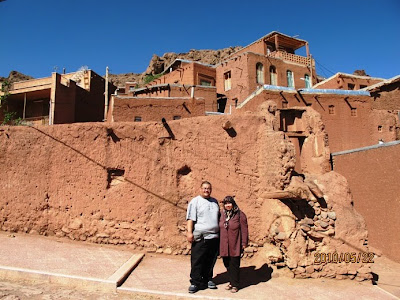
Abyaneh historical village
Salaam,
After a quick lunch at Shandiz in Kashan city, once again we headed south for another 100 kilometers drive and a visit to one of Iran's most famous historical village.
Located on the northwestern slope of the Karkas Mountains, some 20 kilometers away from Natanz, Abyaneh is a village of great antiquity, a living architectural and anthropological museum. It is also a manifestation of an impressive exponent of adaptation of man with his environment.
The ancient village of Abyaneh (or Abianeh) is one of the oldest in Iran dating back to antiquity. Although there is not much record of its past, the remains of a Sasanian fire temple prove its existence and significance during the pre-Islamic period. The word Abyaneh has been derived from the word "viona" meaning willow grove. Its golden age was said to be during the Safavid era.
With a unique reddish hue, the village is compact with narrow and sloped lanes. The houses are located on the slopes of the mountain and arranged in a stair-step shape. Hence the mountain, the houses serve as the courtyard of the other houses higher up on the slope. The alleys are narrow and steep. The materials used for the houses are from red mud bricks for the walls, and timbers, straw and clay for the roofs.
Perhaps the most striking aspect of the Abnayeh village is its architectural uniformity and traditional styles particularly its wooden doors. The simple character found in Abyaneh's houses, the size of the rooms, windows and doors all indicate a picture of simple life in this old village and indeed of rural Iran.
In addition, the traditional Abyaneh costume, such as the attractive traditional women's attire made up of a scarf with floral motifs and pleated pants, are still widely worn and deeply honored until today. In term of ethnography, the village is also a particularly notable site. The tradition-minded and pious descendents of the village are perhaps the only people in Iran to speak the ancient Middle Persian language in their daily conversations.
In a bird's-eye view, the village looks like an oblong bowl encircled by a chain of mountains. Abyaneh's primary claim as a famed and remarkable attraction are manifested in its beautiful natural setting, distinctive red colored mud-brick houses, and most of all the noble and colorful costumes of its womenfolk.
Abyaneh is indeed a museum of historical souvenirs of Iran from ancient time up to today. After walking through its alleys and pathways, one could feel as though we are travelling back in time, to 2000 years ago and walk through all the alleys of history called Abyaneh.
An amazing village with charming sceneries and excellent and noble appearance from the past ages...a window to history...
Wassalam.

 the road leading up to the village...
the road leading up to the village... 
 the village museum...
the village museum...  the entrance...before beginning our walk into history...
the entrance...before beginning our walk into history...  ruins and restoration...
ruins and restoration...  steep in history...
steep in history...  elderly village couple...living tradition
elderly village couple...living tradition  old step and alley...
old step and alley... believed to be remnant/site of the Sasanid era fire temple...
believed to be remnant/site of the Sasanid era fire temple...  Abyaneh's special KFC...
Abyaneh's special KFC... 

















Thanks for sharing this
ReplyDeleteDr Andrew Speirs